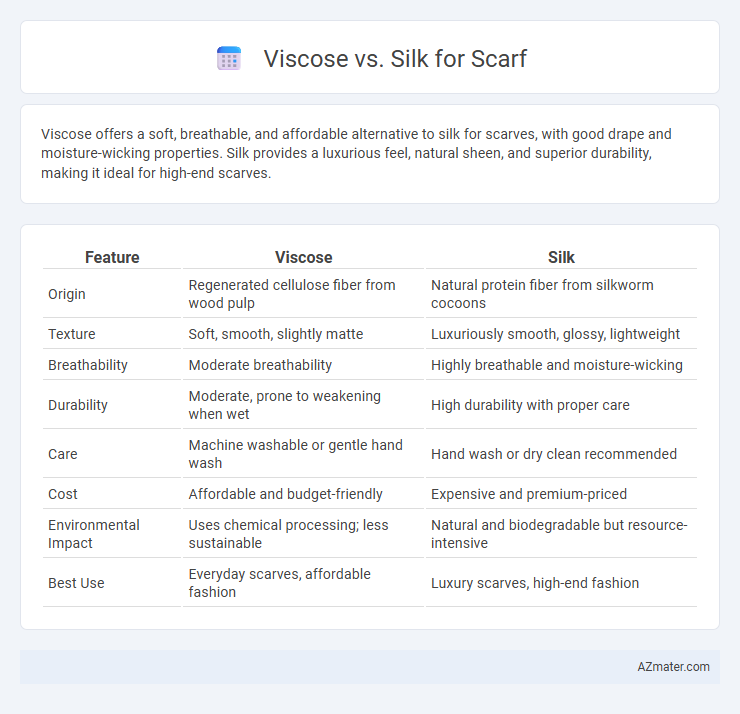Viscose offers a soft, breathable, and affordable alternative to silk for scarves, with good drape and moisture-wicking properties. Silk provides a luxurious feel, natural sheen, and superior durability, making it ideal for high-end scarves.
Table of Comparison
| Feature | Viscose | Silk |
|---|---|---|
| Origin | Regenerated cellulose fiber from wood pulp | Natural protein fiber from silkworm cocoons |
| Texture | Soft, smooth, slightly matte | Luxuriously smooth, glossy, lightweight |
| Breathability | Moderate breathability | Highly breathable and moisture-wicking |
| Durability | Moderate, prone to weakening when wet | High durability with proper care |
| Care | Machine washable or gentle hand wash | Hand wash or dry clean recommended |
| Cost | Affordable and budget-friendly | Expensive and premium-priced |
| Environmental Impact | Uses chemical processing; less sustainable | Natural and biodegradable but resource-intensive |
| Best Use | Everyday scarves, affordable fashion | Luxury scarves, high-end fashion |
Introduction to Viscose and Silk Scarves
Viscose scarves, made from regenerated cellulose fibers, offer a soft, breathable, and affordable alternative to natural fabrics, maintaining a smooth texture that mimics silk. Silk scarves, crafted from natural protein fibers produced by silkworms, provide unmatched luxury, sheen, and durability, prized for their lightweight and hypoallergenic properties. Choosing between viscose and silk scarves depends on preferences for budget, texture, and care requirements, with viscose offering versatility and silk symbolizing elegance.
What Is Viscose?
Viscose is a semi-synthetic fiber made from regenerated cellulose derived from wood pulp, offering a soft and breathable texture often compared to natural fibers like silk. Unlike silk, which is a natural protein fiber produced by silkworms, viscose is more affordable and easier to produce at scale, making it a popular choice for scarves. Its ability to mimic the luxurious feel and drape of silk while being moisture-absorbent and lightweight makes viscose a versatile alternative for fashion accessories.
What Is Silk?
Silk is a natural fiber produced by silkworms, renowned for its smooth texture, lustrous sheen, and exceptional strength. Its protein-based structure offers excellent breathability and moisture-wicking properties, making silk scarves comfortable and suitable for various climates. Compared to viscose, silk provides a luxurious feel and superior durability, though it generally requires more delicate care.
Texture and Feel: Viscose vs Silk
Viscose scarves offer a smooth, soft texture with a lightweight feel, mimicking the silk's sheen at a more affordable price point. Silk scarves provide a luxurious, natural softness and a cool, breathable sensation on the skin, making them ideal for sensitive complexions. The tactile experience of silk is often richer and more refined, while viscose maintains a similar drape and fluidity with a slightly less lustrous finish.
Breathability and Comfort
Viscose offers excellent breathability due to its semi-synthetic cellulose fibers, making it comfortable for warm weather scarves by allowing good air circulation and moisture absorption. Silk, a natural protein fiber, provides superior softness and a smooth texture but tends to retain heat, making it less breathable compared to viscose. For scarves, viscose is often preferred for lightweight, breathable comfort while silk is chosen for luxurious softness and a natural sheen.
Durability and Longevity
Viscose scarves offer moderate durability, maintaining shape and color reasonably well with proper care, but they tend to wear out faster than silk due to their semi-synthetic fibers. Silk scarves are known for exceptional longevity, characterized by strong natural protein fibers that resist pilling and maintain vibrancy over time. Choosing silk ensures a more durable and long-lasting scarf investment, especially when exposed to frequent use and delicate handling.
Care and Maintenance
Viscose scarves require gentle hand washing in cold water with mild detergent to prevent fiber weakening and avoid shrinking, while silk scarves demand delicate care with specialized silk detergents and air drying away from direct sunlight to maintain their natural sheen and smooth texture. Both materials should be stored in cool, dry places, but silk benefits from being wrapped in breathable fabric to prevent damage from friction and moisture. Proper care extends the lifespan of viscose and silk scarves, preserving their softness, color vibrancy, and overall aesthetic appeal.
Sustainability and Environmental Impact
Viscose production involves chemically intensive processes and significant water consumption, leading to deforestation and pollution concerns, whereas silk is a natural protein fiber produced by silkworms with a relatively lower chemical footprint but requires high resource input and labor-intensive harvesting. Both fibers raise sustainability questions, yet eco-friendly viscose alternatives like lyocell use closed-loop processes to minimize environmental harm, while wild or organic silk offers more sustainable silk options. Choosing between viscose and silk scarves depends on prioritizing renewable resource use, chemical impact, and the balance between ecological footprint and garment biodegradability.
Price Comparison: Viscose vs Silk Scarves
Viscose scarves are significantly more affordable, often priced between $10 and $30, while silk scarves usually range from $50 to $200 due to the natural fibers and intricate production process. The cost difference reflects the durability and luxurious feel of silk compared to the budget-friendly and versatile nature of viscose. Consumers seeking elegance at a lower price point commonly choose viscose, whereas those prioritizing premium quality invest in silk scarves.
Which Is Best for You: Viscose or Silk Scarves?
Viscose scarves offer a soft, breathable fabric that mimics the texture of silk but at a more affordable price and with easier care requirements, making them ideal for everyday wear and sensitive skin. Silk scarves provide a luxurious, natural sheen, superior durability, and excellent moisture-wicking properties, perfect for formal occasions and those seeking premium quality. Choosing between viscose and silk scarves depends on your budget, desired fabric feel, and maintenance preferences.

Infographic: Viscose vs Silk for Scarf
 azmater.com
azmater.com